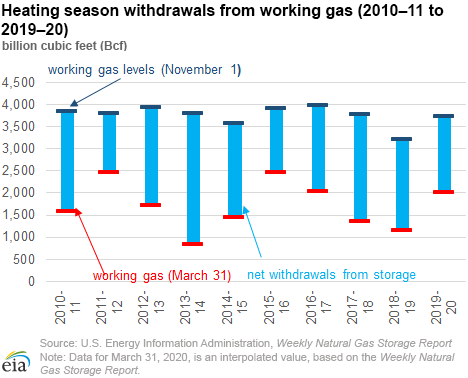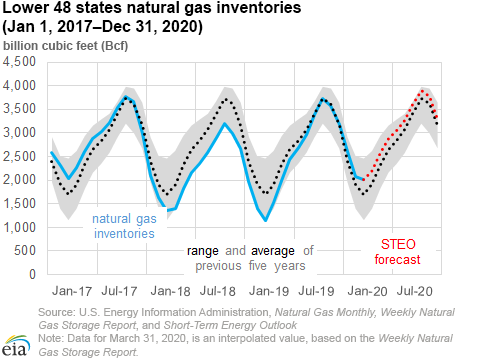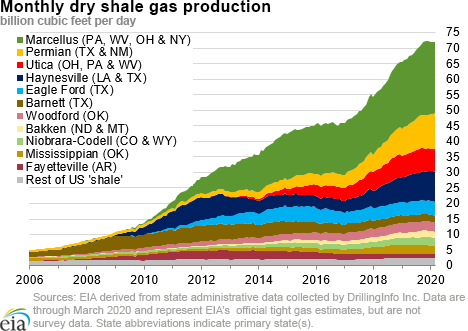Updated 4/23/2020 to fix rig count in text.
In the News:
Natural gas stocks post smallest heating season net withdrawals since 2015
Working natural gas in storage in the Lower 48 states as of March 31, 2020—the traditional end of the heating season that began November 1, 2019— totaled 2,008 billion cubic feet (Bcf), 19% higher than the five-year (2015-19) average for the end of the heating season, according to EIA’s Weekly Natural Gas Storage Report released on April 9. Continued strength in natural gas production, along with reduced heating demand for natural gas as a result of relatively mild winter temperatures throughout most of the Lower 48 states, account for relatively higher inventory levels. This heating season ended at the highest level for working natural gas stocks since 2017 when working natural gas stocks totaled 2,035 Bcf.
Working natural gas stocks totaled 3,575 Bcf entering the winter heating season in November 2019—their highest levels since 2017—after surpassing the five-year average for the first time in two years in October 2019. Total net withdrawals from storage during the 2017–18 heating season were 1,718 Bcf, 14% below the five-year average for the season. The 2019–20 U.S. heating season was characterized by periods of significantly warmer-than-normal temperatures. Cumulative heating degree days (HDDs) were 10% less than normal during the entirety of the 2019-20 heating season, only averaging above normal for the first week of the heating season.
During the 2019-20 heating season, natural gas production posted significant year-over-year increases that more than offset growth in natural gas consumption. Increased liquefied natural gas exports and increased power burn (demand for natural gas electric generators) exceeded the declines in natural gas consumption for residential and commercial customers, which resulted from the relatively mild winter temperatures. This increase in natural gas production resulted in falling natural gas prices, and the surplus in working gas inventory climbed to 316 Bcf by the end of the heating season.
EIA does not expect the working gas inventory surplus to continue to grow during the 2020 refill season (April 1- October 31). EIA’s Short-Term Energy Outlook (STEO) forecasts that natural gas production will decline from year-ago record levels during the summer. These production declines, combined with continued strength in exports, will lead to smaller net injections into working gas. EIA expects that working gas stocks will total 3,904 Bcf, 185 Bcf above the five-year average and 252 Bcf above last year’s level, by the end of the 2020 refill season. The April 2020 STEO forecasts are subject to heightened uncertainty because of the economic slowdown and significant changes in energy markets recently.
Overview:
(For the week ending Wednesday, April 15, 2020)
- Natural gas spot prices fell at most locations this report week (Wednesday, April 8 to Wednesday, April 15). The Henry Hub spot price fell from $1.80 per million British thermal units (MMBtu) last Wednesday to $1.64/MMBtu yesterday.
- At the New York Mercantile Exchange (Nymex), the price of the May 2020 contract decreased 19¢, from $1.783/MMBtu last Wednesday to $1.598/MMBtu yesterday. The price of the 12-month strip averaging May 2020 through April 2021 futures contracts declined 5¢/MMBtu to $2.299/MMBtu.
- The net injection to working gas totaled 73 billion cubic feet (Bcf) for the week ending April 10. Working natural gas stocks total 2,097 Bcf, which is 72% more than the year-ago level and 21% more than the five-year (2015–19) average for this week.
- The natural gas plant liquids composite price at Mont Belvieu, Texas, rose by 31¢/MMBtu, averaging $2.82/MMBtu for the week ending April 15. The price of natural gasoline fell by 2%. The prices of propane, ethane, butane, and isobutane rose by 9%, 11%, 18%, and 18%, respectively. The increase in NGPL values was a result of the rise in crude oil prices during the report week and international NGPL demand remaining robust, allowing prices to correct after significant price declines in past weeks.
- According to Baker Hughes, for the week ending Tuesday, April 7, the natural gas rig count decreased by 4 to 96. The number of oil-directed rigs fell by 58 to 504. The total rig count decreased by 62, and it now stands at 602.
Prices/Supply/Demand:
Prices fall despite widespread cooler-than-normal temperatures. This report week (Wednesday, April 8 to Wednesday, April 15), the Henry Hub spot price fell 16¢ from $1.80/MMBtu last Wednesday to a low of $1.64/MMBtu yesterday. Temperatures were generally cooler than normal, especially across the Great Plains. At the Chicago Citygate, the price decreased 12¢ from $1.75/MMBtu last Wednesday to a low of $1.63/MMBtu yesterday.
California prices are down. The price at SoCal Citygate in Southern California decreased 49¢ from a high of $2.00/MMBtu last Wednesday to a low of $1.51/MMBtu yesterday. The price at PG&E Citygate in Northern California fell 10¢, down from a high of $2.46/MMBtu last Wednesday to $2.36/MMBtu yesterday.
Kinder Morgan’s Ruby Pipeline announced a force majeure on Tuesday until further notice. The outage at the Roberson compressor station, located in southwestern Wyoming, has cut operational capacity by half, from 1.54 Bcf/d to 0.75 Bcf/d, constraining westbound flows through Utah and Nevada and into California markets.
Northeast prices increase. At the Algonquin Citygate, which serves Boston-area consumers, the price went up 11¢ from $1.64/MMBtu last Wednesday to a high of $1.75/MMBtu yesterday. At the Transcontinental Pipeline Zone 6 trading point for New York City, the price increased 8¢ from $1.47/MMBtu last Wednesday to $1.55/MMBtu yesterday.
The Tennessee Zone 4 Marcellus spot price increased 3¢ from $1.36/MMBtu last Wednesday to $1.39/MMBtu yesterday. The price at Dominion South in southwest Pennsylvania fell 2¢ from $1.44/MMBtu last Wednesday to $1.42/MMBtu yesterday.
Permian Basin prices rise as a force majeure is lifted. The price at the Waha Hub in West Texas, which is located near Permian Basin production activities, averaged -$0.02/MMBtu last Wednesday, $1.82/MMBtu lower than the Henry Hub price. Yesterday, the price at the Waha Hub averaged $0.29/MMBtu, $1.35/MMBtu lower than the Henry Hub price. Prices rose as a force majeure on the El Paso Natural Gas pipeline was lifted near Tucson, Arizona, yesterday.
Supply rises slightly. According to data from IHS Markit, the average total supply of natural gas rose by 1% compared with the previous report week. Dry natural gas production remained unchanged week over week. Average net imports from Canada increased by 18% from last week, with most cross-border points being fully utilized.
Demand rises, driven by consumption in buildings. Total U.S. consumption of natural gas rose by 3% compared with the previous report week, according to data from IHS Markit. Natural gas consumed in the residential and commercial sectors increased by 9% as a result of cooler temperatures. The power generation sector was flat, averaging 25.9 Bcf/d. Industrial sector consumption remained unchanged, averaging 20.8 Bcf/d. Natural gas exports to Mexico decreased 8%.
U.S. LNG exports increase week over week. Seventeen LNG vessels (seven from Sabine Pass, four from Corpus Christi, and three each from Cameron and Freeport) with a combined LNG-carrying capacity of 61 Bcf departed the United States between April 9 and April 15, 2020, according to shipping data provided by MarineTraffic.com.
Storage:
The net injections into storage totaled 73 Bcf for the week ending April 10, compared with the five-year (2015–19) average net injections of 27 Bcf and last year's net injections of 73 Bcf during the same week. Working natural gas stocks totaled 2,097 Bcf, which is 370 Bcf more than the five-year average and 876 Bcf more than last year at this time.
According to The Desk survey of natural gas analysts, estimates of the weekly net change to working natural gas stocks ranged from a net injection of 39 Bcf to 78 Bcf, with a median estimate of 67 Bcf.
More storage data and analysis can be found on the Natural Gas Storage Dashboard and the Weekly Natural Gas Storage Report.
See also:
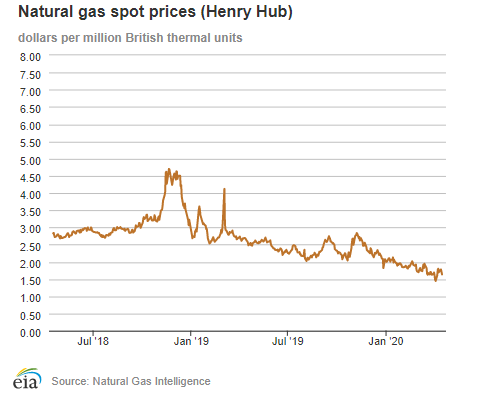
| Spot Prices ($/MMBtu) | Thu, 9-Apr |
Fri, 10-Apr |
Mon, 13-Apr |
Tue, 14-Apr |
Wed, 15-Apr |
|---|---|---|---|---|---|
| Henry Hub | 1.70 | Closed | 1.78 | 1.71 | 1.64 |
| New York | 1.31 | Closed | 1.49 | 1.58 | 1.55 |
| Chicago | 1.67 | Closed | 1.80 | 1.69 | 1.63 |
| Cal. Comp. Avg.* | 1.82 | Closed | 1.92 | 1.78 | 1.79 |
| Futures ($/MMBtu) | |||||
| May Contract | 1.733 | Closed | 1.724 | 1.650 | 1.598 |
| June Contract | 1.863 | Closed | 1.879 | 1.826 | 1.748 |
| *Avg. of NGI's reported prices for: Malin, PG&E Citygate, and Southern California Border Avg. | |||||
| Source: NGI's Daily Gas Price Index | |||||
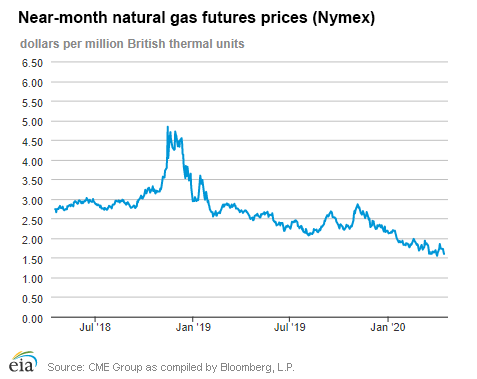
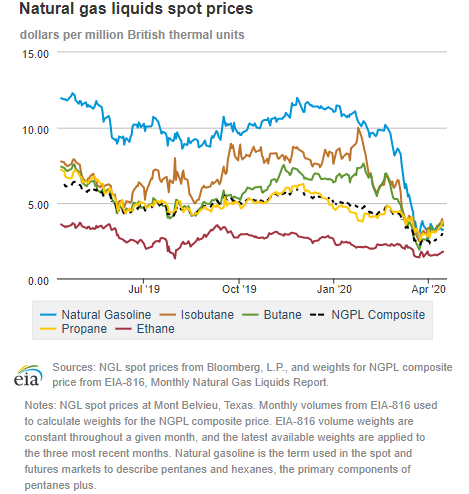
| U.S. natural gas supply - Gas Week: (4/9/20 - 4/15/20) | |||
|---|---|---|---|
Average daily values (Bcf/d): |
|||
this week |
last week |
last year |
|
| Marketed production | 106.0 |
105.9 |
100.6 |
| Dry production | 93.8 |
93.6 |
89.6 |
| Net Canada imports | 4.5 |
3.8 |
4.6 |
| LNG pipeline deliveries | 0.1 |
0.1 |
0.1 |
| Total supply | 98.3 |
97.4 |
94.3 |
|
Source: IHS Markit | |||
| U.S. natural gas consumption - Gas Week: (4/9/20 - 4/15/20) | |||
|---|---|---|---|
Average daily values (Bcf/d): |
|||
this week |
last week |
last year |
|
| U.S. consumption | 68.8 |
67.1 |
67.3 |
| Power | 25.9 |
25.9 |
24.5 |
| Industrial | 20.8 |
20.9 |
22.1 |
| Residential/commercial | 22.1 |
20.3 |
20.8 |
| Mexico exports | 4.5 |
4.9 |
4.9 |
| Pipeline fuel use/losses | 6.5 |
6.5 |
6.3 |
| LNG pipeline receipts | 8.5 |
8.6 |
4.3 |
| Total demand | 88.4 |
87.1 |
82.8 |
|
Source: IHS Markit | |||
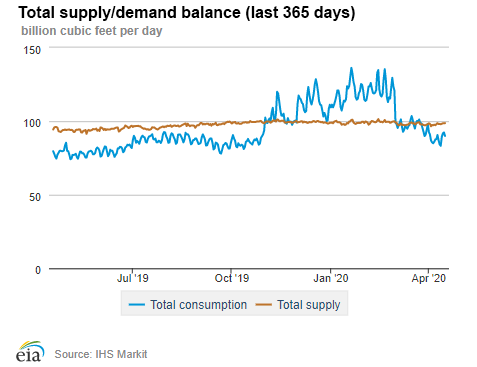
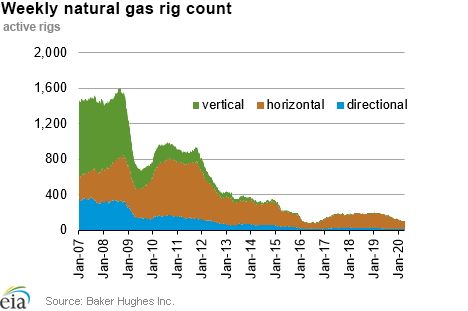
| Rigs | |||
|---|---|---|---|
Tue, April 07, 2020 |
Change from |
||
last week |
last year |
||
| Oil rigs | 504 |
-10.3% |
-39.5% |
| Natural gas rigs | 96 |
-4.0% |
-49.2% |
| Note: Excludes any miscellaneous rigs | |||
| Rig numbers by type | |||
|---|---|---|---|
Tue, April 07, 2020 |
Change from |
||
last week |
last year |
||
| Vertical | 22 |
-26.7% |
-60.0% |
| Horizontal | 545 |
-8.1% |
-38.7% |
| Directional | 35 |
-14.6% |
-55.1% |
| Source: Baker Hughes Inc. | |||
| Working gas in underground storage | ||||
|---|---|---|---|---|
Stocks billion cubic feet (Bcf) |
||||
| Region | 2020-04-10 |
2020-04-03 |
change |
|
| East | 400 |
382 |
18 |
|
| Midwest | 487 |
475 |
12 |
|
| Mountain | 95 |
92 |
3 |
|
| Pacific | 203 |
203 |
0 |
|
| South Central | 912 |
872 |
40 |
|
| Total | 2,097 |
2,024 |
73 |
|
|
Source: Form EIA-912, Weekly Underground Natural Gas Storage Report | ||||
| Working gas in underground storage | |||||
|---|---|---|---|---|---|
Historical comparisons |
|||||
Year ago (4/10/19) |
5-year average (2015-2019) |
||||
| Region | Stocks (Bcf) |
% change |
Stocks (Bcf) |
% change |
|
| East | 223 |
79.4 |
274 |
46.0 |
|
| Midwest | 250 |
94.8 |
353 |
38.0 |
|
| Mountain | 65 |
46.2 |
112 |
-15.2 |
|
| Pacific | 125 |
62.4 |
213 |
-4.7 |
|
| South Central | 557 |
63.7 |
776 |
17.5 |
|
| Total | 1,221 |
71.7 |
1,727 |
21.4 |
|
| Source: Form EIA-912, Weekly Underground Natural Gas Storage Report | |||||
| Temperature – heating & cooling degree days (week ending Apr 09) | ||||||||
|---|---|---|---|---|---|---|---|---|
HDD deviation from: |
CDD deviation from: |
|||||||
| Region | HDD Current |
normal |
last year |
CDD Current |
normal |
last year |
||
| New England | 129 |
-26 |
-26 |
0 |
0 |
0 |
||
| Middle Atlantic | 95 |
-43 |
-14 |
0 |
0 |
0 |
||
| E N Central | 107 |
-36 |
9 |
0 |
0 |
0 |
||
| W N Central | 133 |
-3 |
40 |
3 |
2 |
3 |
||
| South Atlantic | 35 |
-36 |
-2 |
27 |
14 |
0 |
||
| E S Central | 26 |
-40 |
-4 |
14 |
9 |
4 |
||
| W S Central | 31 |
-3 |
21 |
38 |
22 |
1 |
||
| Mountain | 120 |
-7 |
34 |
2 |
-4 |
-6 |
||
| Pacific | 113 |
38 |
55 |
0 |
-2 |
0 |
||
| United States | 91 |
-16 |
16 |
11 |
7 |
0 |
||
|
Note: HDD = heating degree day; CDD = cooling degree day Source: National Oceanic and Atmospheric Administration | ||||||||
Average temperature (°F)
7-day mean ending Apr 09, 2020
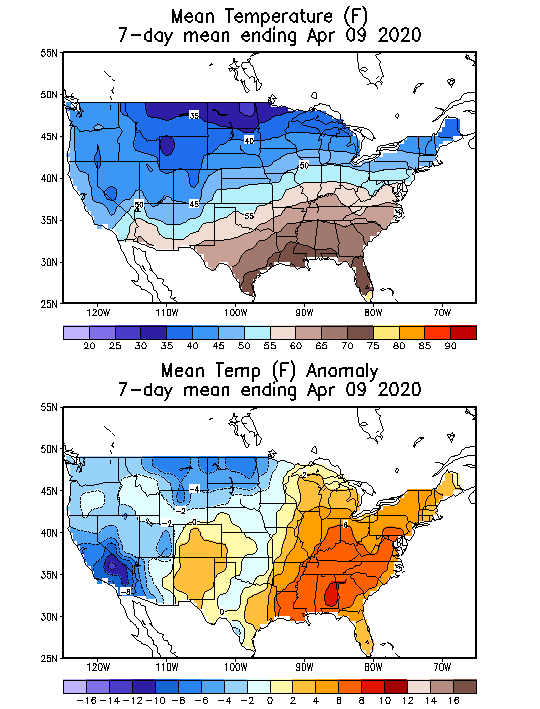
Source: National Oceanic and Atmospheric Administration
Deviation between average and normal (°F)
7-day mean ending Apr 09, 2020

Source: National Oceanic and Atmospheric Administration

